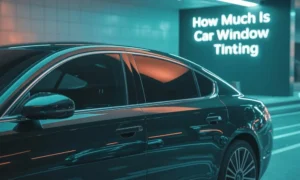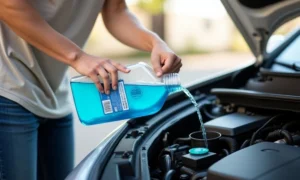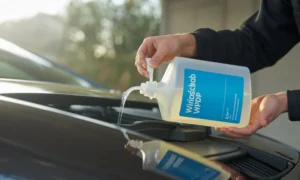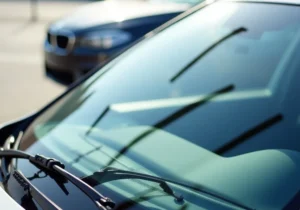How Much Is Car Window Tinting How much is car window tinting? Car window tinting...
Car Window Tinting Near Me: The Ultimate Guide by Texas Reliable Auto Glass
Are you on the lookout for a simple yet effective way to not only augment the appearance of your vehicle but also provide yourself with protection against the glaring sun and the prying eyes of curious onlookers? Your solution might just lie in the art of car window tinting! In this comprehensive and enlightening guide, generously brought to you by the experts at Texas Reliable Auto Glass, we’re prepared to walk you through the ins and outs of car window tinting. By the end of this guide, you’ll have a firm grasp on why car window tinting is a fantastic choice for your car, how it’s done, and the numerous advantages it offers.
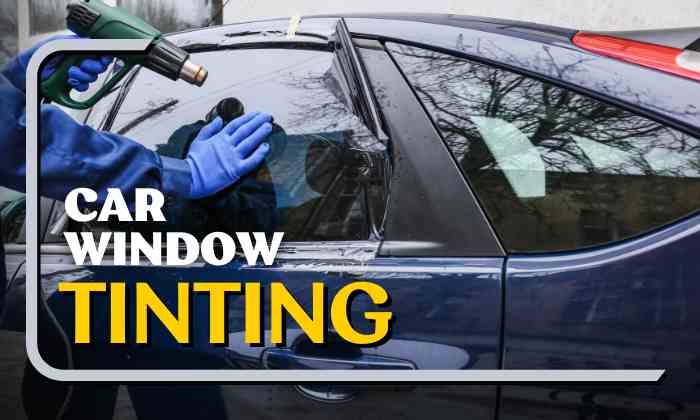
Why Opt for Car Window Tinting?
When it comes to upgrading your vehicle, car window tinting emerges as a remarkably practical and stylish choice. The benefits extend beyond mere aesthetics, encompassing a multitude of reasons that make this option so appealing. By choosing car window tinting, you’re not only enhancing the overall look of your vehicle, but you’re also making a decision that contributes to your comfort, privacy, and even the longevity of your car’s interior components.
The primary advantage of car window tinting is the protection it offers against the sun’s harsh rays. Harmful ultraviolet (UV) rays can cause fading and deterioration of your vehicle’s interior over time. With the right tint, you can significantly reduce the amount of UV radiation that enters your car, safeguarding your upholstery, dashboard, and other interior elements from premature wear and tear.
Additionally, tinted windows help to regulate the temperature within your vehicle. By blocking a considerable amount of solar heat, the interior remains cooler, creating a more comfortable driving experience, especially during scorching summers. This reduced reliance on air conditioning can also have a positive impact on your car’s fuel efficiency.
Furthermore, car window tinting enhances privacy by limiting the view into your vehicle’s interior. This is particularly beneficial when you’re parked in a busy area or simply want some personal space while driving. You can enjoy your journey without feeling like you’re on display to the world.
Opting for car window tinting isn’t merely a functional decision – it’s a stylistic one too. The sleek and sophisticated appearance that tinted windows provide can elevate the overall look of your vehicle. Whether you prefer a subtler tint or a more dramatic shade, you have the flexibility to choose a tint that complements your personal style.
In essence, choosing car window tinting is about more than just improving the appearance of your vehicle – it’s a practical investment that brings a range of benefits. From protecting your car’s interior to enhancing your driving comfort and privacy, tinted windows offer a well-rounded solution for vehicle owners looking to elevate their driving experience.
The Process of Car Window Tinting
The process of car window tinting involves a series of meticulous steps to ensure a seamless application that not only enhances the aesthetics of your vehicle but also provides you with all the benefits it has to offer. Here’s a comprehensive breakdown of what you can expect during the car window tinting process:
Cleaning and Preparation
Before any tinting film is applied, the windows of your vehicle are thoroughly cleaned and prepared. This step ensures that there’s no dirt, dust, or residue that could interfere with the adhesion of the tinting material.
Measuring and Cutting
Precise measurements of your windows are taken to ensure the tinting film is cut to fit perfectly. Experienced professionals carefully measure each window, accounting for any curves or unique shapes, to create a customized film that matches the dimensions accurately.
Film Application
Once the tinting film is cut to size, it’s time for application. A special adhesive is applied to the film, which allows it to adhere to the window surface. The film is then carefully positioned and applied to the interior side of the window glass.
Squeegeeing and Air Removal
To ensure a smooth and bubble-free finish, the tinting film is squeegeed onto the window. This step helps to eliminate any air bubbles that may have formed during the application process, resulting in a flawless and even appearance.
Drying and Curing
After the film is properly applied, it needs time to dry and cure. This step is crucial for the film to fully adhere to the window and achieve its desired properties. It’s important to avoid rolling down the windows during this curing period to prevent any disturbance to the film.
Final Inspection
Once the tinting film has dried and cured, a final inspection is conducted to ensure that the application is impeccable. Professionals check for any imperfections, bubbles, or irregularities and address them if necessary.
Quality Assurance
At Texas Reliable Auto Glass, we prioritize quality assurance. We ensure that every aspect of the tinting process meets our high standards, from the materials used to the precision of the application.
With this thorough and systematic process, you can rest assured that your vehicle’s windows will be treated with the utmost care and expertise. The end result? Tinted windows that not only enhance the aesthetics of your vehicle but also provide you with the comfort, protection, and privacy you deserve.
The Process of Car Window Tinting
Car window tinting is a meticulous and skillful process that involves several steps to achieve a professional and seamless result. Whether you’re seeking to enhance your vehicle’s appearance or enjoy the benefits of increased privacy and sun protection, understanding the steps involved in car window tinting can help you make an informed decision. Here’s an overview of the process:
Preparation and Cleaning
The first step in car window tinting is preparing the windows. Professionals thoroughly clean the interior side of the windows to remove any dirt, dust, or debris that could affect the tint’s adhesion. Clean windows ensure a smooth and durable application.
Measurement and Cutting
Accurate measurements of each window are taken to custom-cut the tinting film. Professionals measure the dimensions of the windows precisely, ensuring that the film fits perfectly without any gaps or overlaps.
Film Application
Once the tinting film is cut to the right size, it’s time for application. An adhesive layer is applied to the film, allowing it to stick to the glass. The film is then carefully placed on the inside of the window and aligned correctly.
Removing Air Bubbles
To achieve a flawless appearance, professionals use tools to carefully smooth out the film and remove any trapped air bubbles. This step requires precision to ensure a seamless finish.
Drying and Setting
After the film is applied, it needs time to dry and set properly. This period allows the adhesive to bond securely to the glass, ensuring the tint remains in place. During this time, it’s important to avoid rolling down the windows.
Final Inspection
Once the tint is completely set, a thorough inspection is carried out. Professionals examine the windows for any imperfections, ensuring that the tint is uniform, free of bubbles, and properly aligned.
Quality Assurance
At Texas Reliable Auto Glass, we prioritize quality at every stage. Our experts ensure that the tinting process meets the highest standards, from the quality of the film to the precision of the application.
By following these steps with precision and care, car window tinting professionals can transform your vehicle’s appearance and provide you with the benefits of added comfort, privacy, and UV protection. If you’re looking to enhance your driving experience, car window tinting could be the perfect solution for you.
Factors Affecting Car Window Tinting Cost
The cost of car window tinting can vary based on several factors that influence the overall pricing of the service. Knowing these things can help you make an informed choice and plan your finances appropriately. Here are the key elements that affect the cost of car window tinting:
Type of Tinting Film
The type of tinting film you choose significantly impacts the cost. Basic dyed films are typically more affordable, while advanced ceramic or high-performance films come at a higher price due to their enhanced features, such as better heat rejection and UV protection.
Number of Windows
The number of windows you want to tint affects the overall cost. Tinting all windows, including the rear windshield and side windows, will naturally be more expensive than tinting only a few selected windows.
Window Size and Shape
Larger windows or windows with complex shapes might require more film material and meticulous cutting, leading to increased labor and material costs.
Tint Darkness or Shade
Different states and regions have regulations regarding the darkness of tinted windows. If you opt for a darker shade of tint that complies with regulations, it might be more expensive due to the quality of the film and the meticulous application required.
Vehicle Type
The size and type of your vehicle play a role in determining the cost. Smaller vehicles generally have fewer windows to tint, whereas larger vehicles like SUVs or vans might have more windows and larger surface areas, contributing to higher costs.
Labor Costs
Experienced professionals ensure a high-quality tint application, but their expertise comes at a cost. Labor charges vary based on the complexity of the installation and the reputation of the tinting service provider.
Additional Services
Some providers offer additional services as part of the package, such as removing old tint, applying sunstrips, or installing UV-protective films. These extras may affect the final price.
Warranty and Quality
High-quality tinting materials and professional installation often come with warranties against fading, bubbling, or peeling. Choosing a reputable service with a strong warranty might come at a higher upfront cost but could save you money in the long run.
Location
Tinting costs can vary based on your location.Prices may be a little bit more in urban locations or regions with a higher cost of living than in rural areas.
When considering car window tinting, it’s essential to consult with a professional and request a detailed quote based on your specific needs and preferences. This will give you a clear understanding of the cost breakdown and allow you to make an informed decision that aligns with your budget and requirements.
Choosing the Right Tint
Selecting the appropriate tint for your car’s windows involves more than just picking a shade that looks appealing. It requires considering various factors to ensure you achieve the desired balance between aesthetics, functionality, and legal compliance. Here’s a guide to help you choose the right tint for your vehicle:
Local Tinting Laws
Before anything else, familiarize yourself with your local tinting laws. Different states and regions have regulations regarding the allowable darkness of tinted windows. Ensure that the tint you choose complies with these laws to avoid potential fines or issues.
Tint Shades and Darkness
Tint shades are typically measured in terms of VLT (Visible Light Transmission), indicating the percentage of light that can pass through the tint. For instance, a 5% VLT means only 5% of light enters, creating a very dark tint. Consider your preferences and how dark you’re comfortable with, while also adhering to legal limits.
Tint Types
There are various types of tint films available, each with its own set of features:
- Dyed Film: Offers a matte appearance and can reduce glare and heat. It’s budget-friendly but might not be as effective in heat rejection as other options.
- Metalized Film: Contains small metallic particles that enhance heat and UV rejection. It provides a reflective appearance and can interfere with electronic signals.
- Carbon Film: Offers enhanced heat rejection and doesn’t interfere with signals. It has a sleek appearance and is ideal for those looking for performance and aesthetics.
- Ceramic Film: Provides top-tier heat rejection, UV protection, and signal clarity. It’s the most advanced and costly option but offers excellent performance.
UV Protection and Heat Rejection
Consider the level of UV protection and heat rejection you need. High-quality tints, especially ceramic ones, offer superior protection against UV rays and can significantly reduce heat buildup in your vehicle.
Aesthetic Preferences
The tint you choose can greatly impact the look of your vehicle. Consider the overall aesthetics you’re aiming for – whether you prefer a subtle, sophisticated appearance or a more striking and dramatic effect.
Quality and Brand
Invest in reputable brands known for their quality. High-quality tints are likely to come with warranties against fading, peeling, or bubbling.
Professional Installation
No matter the tint you choose, professional installation is crucial.It’s possible for improper installation can cause bubbling, peeling, and decreased visibility. Choose an experienced installer to ensure the tint is applied seamlessly.
By considering these factors and discussing your preferences with a professional, you can make an informed decision and choose a tint that not only enhances the look of your vehicle but also provides the functionality you need while complying with local regulations.
Benefits Beyond Aesthetics
Car window tinting offers a range of advantages that extend well beyond its aesthetic appeal. While the sleek and sophisticated appearance is a significant draw, the functional benefits it provides make it a practical and worthwhile investment. Let’s explore the benefits that car window tinting brings beyond just enhancing the looks of your vehicle:
UV Protection
Tinted windows act as a shield against harmful ultraviolet (UV) rays from the sun. Prolonged exposure to UV rays can lead to skin damage, premature aging, and even skin cancer. Tinting reduces UV radiation that enters the vehicle, safeguarding you and your passengers from these risks.
Heat Rejection
Tinted windows can significantly reduce the amount of heat that enters your vehicle. This is particularly beneficial during hot summer months. By blocking a portion of the sun’s heat, tinting helps keep the interior cooler, reducing the need for excessive air conditioning and improving fuel efficiency.
Glare Reduction
Glare from the sun or headlights of other vehicles can be not only uncomfortable but also hazardous. Tinted windows help mitigate glare, enhancing visibility and reducing eye strain. This leads to a more comfortable and safer driving experience, especially during bright and sunny conditions or nighttime driving.
Enhanced Privacy
Privacy is a crucial factor for many drivers. Tinted windows obscure the view into your vehicle, providing you with a higher level of privacy. This is particularly useful when you’re parked in public spaces or waiting at traffic lights.
Interior Preservation
Tinted windows can help protect your vehicle’s interior from fading and deterioration caused by prolonged exposure to sunlight. UV rays can lead to the fading of upholstery, dashboard materials, and other components. Tinting acts as a barrier, prolonging the life and quality of your vehicle’s interior.
Shattered Glass Protection
In the unfortunate event of an accident, tinted windows can prevent shattered glass from scattering within the vehicle. The film holds the glass together, reducing the risk of injury to occupants.
Energy Savings
Reducing the need for excessive air conditioning due to heat reduction can result in energy savings and improved fuel efficiency, contributing to a more environmentally friendly driving experience.
Customized Appearance
Beyond the functional benefits, tinted windows can enhance the overall appearance of your vehicle. You have the flexibility to choose a tint shade that complements your vehicle’s color and style, creating a more cohesive and visually appealing look.
In conclusion, car window tinting offers a wealth of advantages that enhance your driving experience in multiple ways. From protecting your health to increasing comfort and safety, tinted windows provide a practical solution that goes beyond mere aesthetics. It’s a decision that combines style, functionality, and well-being, making it a valuable addition to any vehicle.
Caring for Your Tinted Windows
Congratulations on getting your windows tinted! To ensure your investment lasts and continues to enhance your driving experience, it’s essential to properly care for your tinted windows. Following a few simple guidelines will help maintain their appearance and functionality for years to come. Here’s how to care for your tinted windows:
Wait Before Rolling Down Windows
After getting your windows tinted, it’s crucial to wait a few days before rolling them down. This allows the tint to fully adhere to the glass. Premature rolling down of the windows could disrupt the tint’s placement and lead to bubbling or peeling.
Be Gentle During Cleaning
When cleaning your tinted windows, use a gentle touch. Avoid abrasive materials, such as rough sponges or brushes, as they can scratch the tint. Opt for a soft, non-abrasive microfiber cloth and a mild, ammonia-free cleaner.
Choose the Right Cleaning Products
Using the wrong cleaning products can damage the tint. Steer clear of cleaners that contain ammonia, as they can break down the adhesive and cause the tint to deteriorate over time. Stick to products specifically formulated for tinted windows.
Avoid Sharp Objects
Be cautious when placing or removing items from your windows. Sharp objects, like keys or jewelry, can scratch the tint. Place items gently and ensure they don’t come into direct contact with the tinted surface.
Use Caution with Stickers and Decals
If you plan to add stickers or decals to your windows, choose a location that won’t interfere with the tint. Applying stickers directly onto the tint could damage it when you eventually need to remove them.
Regularly Inspect for Issues
Periodically inspect your tinted windows for any signs of damage, bubbling, or peeling. Early detection of problems allows for timely repairs, ensuring the longevity of the tint.
Consult Professionals for Repairs
If you notice any issues with your tinted windows, such as peeling or bubbling, don’t attempt to fix them yourself. Instead, consult professionals who specialize in window tinting. DIY repairs could worsen the problem.
Avoid Harsh Sunlight in the Beginning
During the first few weeks after tinting, try to avoid parking your vehicle in direct sunlight for extended periods. This precaution helps the tint fully adhere and set properly.
Regular Maintenance
Tinted windows require regular maintenance to retain their appearance. By incorporating gentle cleaning into your routine, you can prevent dirt and debris buildup that might affect the tint’s clarity.
By following these care tips, you’ll not only preserve the sleek appearance of your tinted windows but also ensure their functionality and longevity. Proper care allows you to enjoy the benefits of window tinting for years while maintaining the overall value and appearance of your vehicle.
Common Misconceptions About Car Window Tinting
Car window tinting has gained popularity for its numerous benefits, but there are still some misconceptions that persist. Let’s address these misconceptions and provide clarity on what’s true and what’s not when it comes to tinting your vehicle’s windows:
Tinted Windows Are Too Dark to See Through at Night
One common misconception is that tinted windows obstruct visibility, especially at night. However, when installed correctly and within legal limits, tinted windows do not significantly affect visibility. Modern tinting technology allows for various levels of tint darkness that can enhance privacy without compromising safety.
Tinted Windows Block All Electronic Signals
While older metallic-based tints might have interfered with electronic signals like GPS and cell phone reception, today’s quality tinting films do not pose such problems. High-quality ceramic and non-metallic films are designed to allow signals to pass through without disruption.
Tinting Is Only for Aesthetics
While enhanced aesthetics are a notable benefit of window tinting, it offers more than just a stylish appearance. Tinted windows provide UV protection, reduce heat buildup, minimize glare, and enhance privacy – making them a practical choice for comfort and safety.
Tinting Is a Permanent Decision
Tinting is not a permanent alteration to your vehicle. High-quality tints are designed to be removable without damaging the glass. If you decide to change or remove the tint, it can be done by professionals without leaving a residue.
All Tints Are the Same
There’s a misconception that all tints offer the same benefits and quality. In reality, there are various types of tinting films with different features. Premium films, such as ceramic films, provide better heat rejection, UV protection, and longevity compared to basic options.
Tinting Is Expensive and Not Worth It
While there’s an upfront cost to tinting, the benefits it provides in terms of UV protection, heat reduction, and interior preservation make it a valuable investment. Additionally, prices vary based on the type of tint and the size of your vehicle.
Tinting Is Illegal Everywhere
Tinting laws vary from state to state and country to country. It’s important to familiarize yourself with your local regulations to ensure you comply with legal limits for tint darkness. Many places allow a certain level of tinting that provides benefits while remaining within the law.
DIY Tinting Is as Effective as Professional Installation
DIY tinting kits might be tempting, but achieving a seamless and bubble-free result requires skill and experience. Professional installation ensures proper application, reducing the risk of defects and ensuring the tint’s longevity.
Tinting Must Be Extremely Dark to Be Effective
The darkness of the tint doesn’t necessarily correlate with its effectiveness. Even lighter tints can provide UV protection and heat reduction while adhering to legal limits. The choice of tint darkness depends on your preferences and needs.
By dispelling these misconceptions, you can make a well-informed decision about car window tinting. Understanding the benefits and limitations of tinting allows you to enjoy its advantages while making choices that align with your needs and preferences.
Conclusion
In the world of automotive enhancement, car window tinting from Texas Reliable Auto Glass emerges as a multifaceted solution that seamlessly blends style, protection, and practicality. Beyond the allure of a sleek and sophisticated appearance, the benefits of window tinting extend to a realm of comfort, safety, and preservation. As we’ve explored in this comprehensive guide, the advantages of car window tinting are manifold.
At Texas Reliable Auto Glass, we stand as your trusted partner in this transformative journey. Our commitment to quality, precision, and customer satisfaction ensures that you receive the best in both product and service. With car window tinting, you’re not merely enhancing your vehicle – you’re enhancing your driving experience.
So, whether you’re cruising down city streets or embarking on an open road adventure, let your tinted windows be a testament to your commitment to style, comfort, and well-being. Elevate your drive with Texas Reliable Auto Glass and embrace the world of car window tinting.
FAQs
- Is car window tinting legal in all states?
Car window tinting regulations vary by state and country. It’s important to check your local laws to ensure you comply with allowable tint darkness limits. Most places have specific regulations regarding how dark your windows can be.
- Will tinting my windows affect visibility at night?
When installed within legal limits and with quality materials, tinted windows should not significantly impact visibility at night. Modern tinting technology allows for varying levels of tint darkness that strike a balance between aesthetics and safety.
- Can I roll down my tinted windows immediately after installation?
It’s recommended to wait a few days before rolling down your newly tinted windows. This allows the tint to properly adhere to the glass without risking peeling or bubbling.
- Can I clean tinted windows like regular windows?
While you can clean tinted windows, it’s important to use gentle cleaning methods. Avoid abrasive materials and ammonia-based cleaners, as they can damage the tint. Use a soft cloth and a mild, non-ammonia cleaner designed for tinted windows.
- Is professional installation necessary for window tinting?
Professional installation is highly recommended for window tinting. Proper installation requires skill and experience to ensure a seamless and bubble-free result. DIY kits might lead to suboptimal outcomes and decreased tint longevity.
- What is the difference between various types of tinting films?
Different types of tinting films, such as dyed, metallic, carbon, and ceramic films, offer varying levels of heat rejection, UV protection, and signal clarity. Higher-quality films, like ceramic ones, tend to provide better performance and longevity.
- Can window tinting protect against fading of my car’s interior?
Yes, window tinting can provide protection against fading of your car’s interior caused by UV rays. Tinted windows act as a barrier, reducing the amount of UV radiation that enters the vehicle and minimizing fading over time.
- Can tinting help reduce energy consumption?
Tinted windows can reduce the heat buildup in your vehicle, allowing you to rely less on air conditioning. This can lead to energy savings and improved fuel efficiency.
- Is there a warranty for tinted windows?
Reputable tinting service providers often offer warranties against issues like fading, peeling, and bubbling. Make sure to inquire about warranty details when getting your windows tinted.
- How often do tinted windows need maintenance?
Regular maintenance for tinted windows involves gentle cleaning to prevent dirt buildup. Periodic inspections can help you catch any issues early, ensuring the tint’s longevity and performance.
Our Services
Our Latest Blogs
How Do You Unfreeze Windshield Wiper Fluid
How Do You Unfreeze Windshield Wiper Fluid How do you unfreeze windshield wiper fluid during...
How To Refill Windshield Wiper Fluid
How To Refill Windshield Wiper Fluid How to refill windshield wiper fluid is a simple...
What Kind Of Windshield Wipers Do I Need
What Kind Of Windshield Wipers Do I Need What kind of windshield wipers do I...


